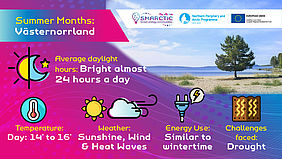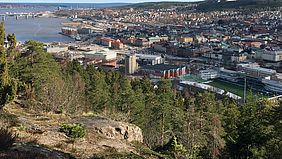Countries in the Northern Periphery and Arctic area face some challenges that affect indoor environment not only during winter months, but also during the summer. This week, we speak with our partners in Västernorrland (Sweden) about environmental factors during the region’s warmest months of the year and how these impact the use of energy whilst indoors.
The average of daylight hours is the first factor that impacts the indoor environment of this region. Our SMARCTIC partner Marta Bystrowska, from the Regional Council of Västernorrland, explains that around Summer Solstice (21st June) the sun sets at approximately 23:00 and rises again at approximately 03:00. This means that there is brightness almost 24 hours a day in the summertime and, in consequence, the use of energy decreases as less energy is required to produce artificial light. Nevertheless, as the region is located in the Northern Europe, usually by the end of August the darker nights quickly return. She adds that during the whole month of August, the average darkness hours are between 200 and 220 hours.
The region’s average temperature in July lays around 14-16 degrees. This factor also decreases the necessity for large energy expenditure in comparison to winter months. “Summers may be short, but temperatures are often a comfortable 15 degrees, with occasional peaks of up to 30 degrees”, adds Marta. She highlights that heat waves are becoming more and more common, and, for that reason, A/C is commonly used in domestic or public settings in summer for cooling purposes.
Even though the daylight hours and temperatures make life of local communities easier than during the wintertime, the droughts are becoming a problem both in the region as well as in the whole of Sweden. “In 2018, large forest fires required international efforts to extinguish. In 2020, fire restrictions caused by drought were implemented in Västernorrland by June”. In terms of weather, she adds that in coastal areas stronger winds and storms may also occur.
According to Marta, it is difficult to determine if there is an average increase or reduction in energy use during summer months. “The energy consumption in the region is generally quite big, mostly due to heavy industries like paper pulp and aluminium. Energy use by private households is, thus, not easy to assess”, she concludes.
Are you curious about what happens in Västernorrland during winter months? Stay tuned with SMARCTIC!


